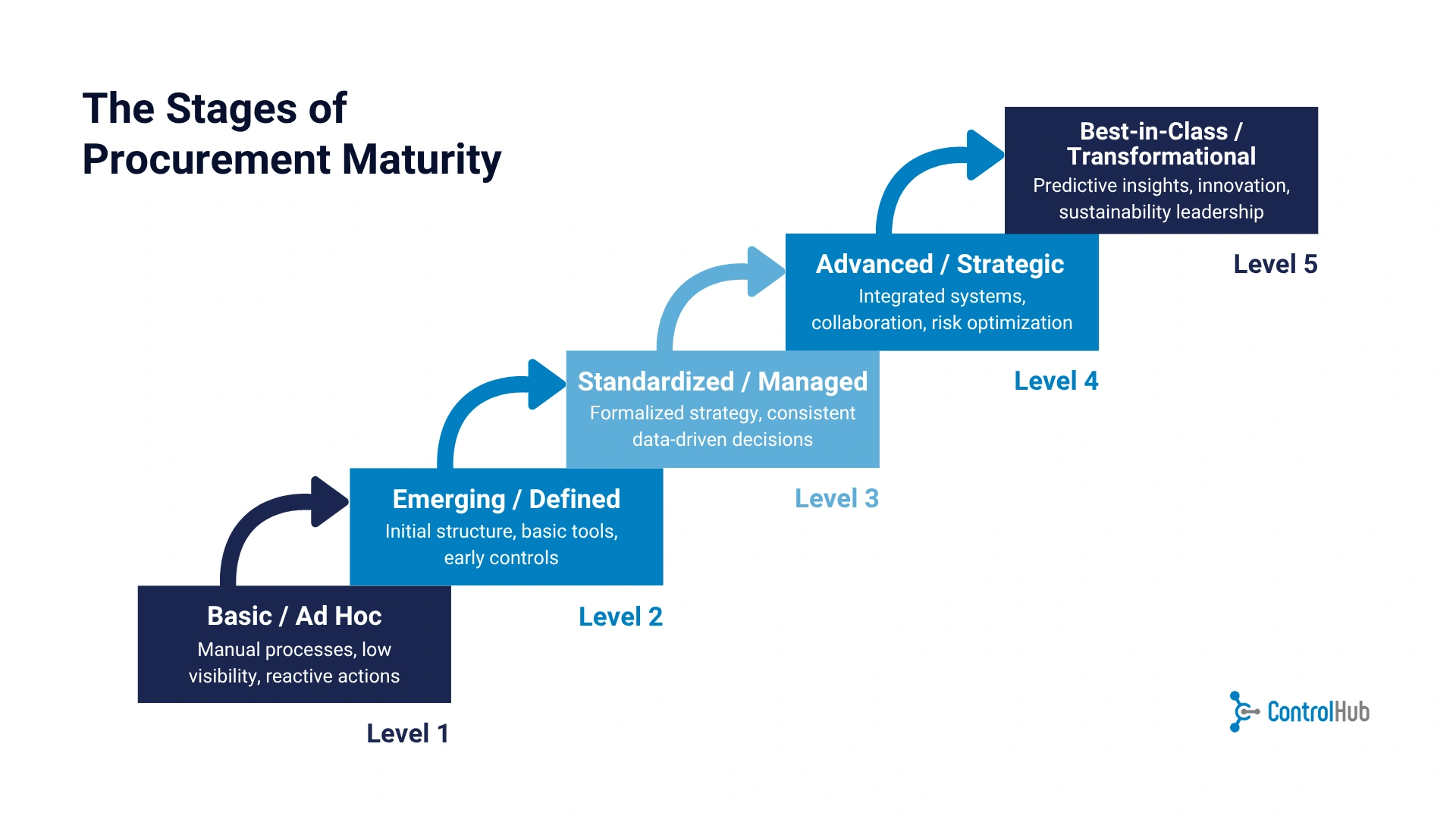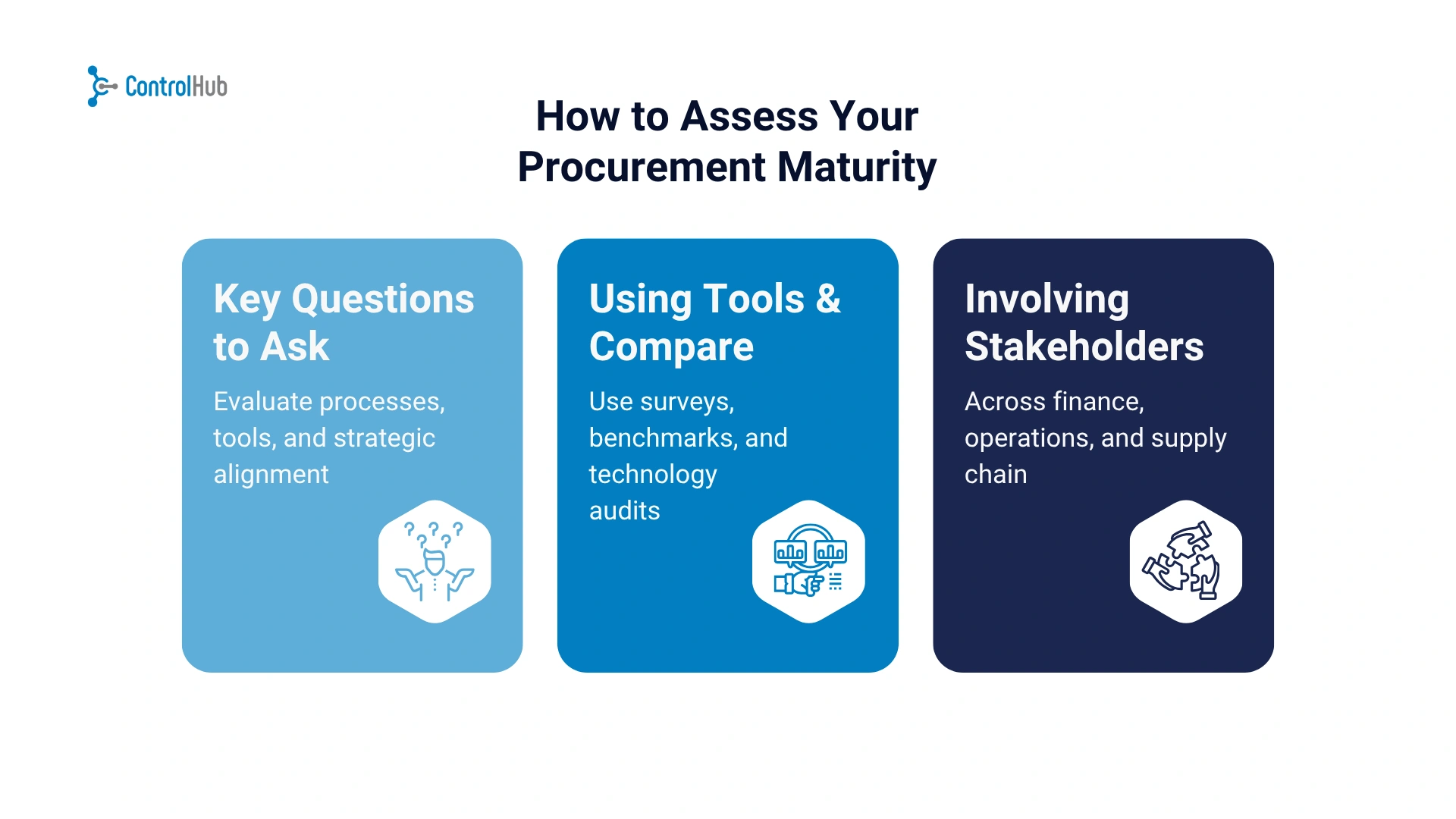Free Supplier Risk Scorecard Download
Download our free supplier risk scorecard here!
Download the free tool!AI Summarize:
Have you ever thought about what maturity level your procurement is?
Yes, believe it or not, procurement can indeed grow across different stages.
Think of it as a pathway where your business starts with little knowledge and ends with lots of strategic insights and purchasing power.
While it might sound like yet another theoretical framework you need to spend hours on, it's actually quite practical.
The Stages of Procurement Maturity
1. Level 1 – Basic / Ad Hoc
At this stage, procurement is mostly reactive; things get purchased when someone suddenly realizes they’re needed.
There’s no real planning, just quick fixes to keep operations moving.
Most decisions depend on whoever’s available, what vendor they know, or who can deliver fastest.
It’s not that anyone’s doing something wrong; it’s just that procurement hasn’t yet been treated as a structured, strategic function.
Processes are manual: emails, spreadsheets, and some calls.
The messier the better.
There’s little visibility into total spending, so you have no idea where the money goes. This leads to duplicated orders, inconsistent pricing, and missed savings.
Supplier relationships are purely transactional with no real value.
And each department might have its own way of buying, creating a chaotic, fragmented system overall.
When It’s Most Common
You’ll see this stage in early-stage startups, small businesses, or growing companies that haven’t built formal processes yet. Sometimes, even mid-sized organizations slip into it after rapid growth; they scale operations but not procurement discipline.
2. Level 2 – Emerging / Defined
Here, you can start seeing the first attempts to use procurement software or tracking tools, which already make a big difference. The process is still slow, but at least there is a process now.
Pros and Cons
Pros:
Better visibility into spend and supplier activity
Fewer duplicated purchases or last-minute rush orders
Initial leverage in negotiations thanks to some spend data
Cons:
Processes are still partly manual and inconsistent
Limited integration with other departments or systems
Compliance and policy adoption vary by team
When It’s Most Common
You’ll typically find this level in growing mid-sized companies or startups entering a scaling phase. Procurement has become noticeable enough to need structure, but not mature enough to be strategic yet.
3. Level 3 – Standardized / Managed
So at this point, you've reached stability for your business, you know you are growing steadily, and your procurement process is consistent across departments, and you’re starting to use data to make smarter calls.
You might even have supplier scorecards or performance metrics to help you decide who’s worth sticking with.
The goal isn’t just buying, it’s buying better and aligning with your general business goals.
Supplier relationships also mature here. You’re not just chasing the lowest price; you’re looking for reliability, quality, and alignment.
When It’s Most Common
Think of established mid-sized companies or larger organizations tightening their operations.
4. Level 4 – Advanced / Strategic
Procurement is tightly linked with finance, operations, and product teams, and decisions are made with full visibility into spend, performance, and risk. You’re probably running category management, using integrated software, and tracking supplier KPIs in real time. It’s less about transactions now and more about long-term value creation.
Characteristics
Procurement data is connected across the business. messy spreadsheets? Forgotten.
Strong supplier collaboration and regular performance reviews
Predictive analytics start coming into play for demand and pricing
Risk management and sustainability are part of procurement goals
Teams operate with clear accountability and measurable KPIs
Benefits
Major efficiency gains through automation and insights
Reduced costs and improved supplier reliability
Better alignment between procurement and company strategy
Higher internal trust and faster decision-making
When It’s Most Common
Large, mature organizations or fast-scaling enterprises that treat procurement as a competitive advantage, not just a back-office function.
Level 5 – Best-in-Class / Transformational
Procurement is now fully integrated with every department, using predictive analytics, automation, and AI to anticipate needs before they even arise. You’ve moved from being a cost center to creating value.
At this level, your team doesn’t just manage suppliers; you partner with them. Collaboration leads to innovation, new materials, improved designs, faster launches, and shared sustainability goals. Every decision is backed by real-time data, and continuous improvement is simply how you operate.
Procurement performance is tied directly to business outcomes, profitability, resilience, and reputation. It’s not just about savings anymore; it’s about impact.
When It’s Most Common
You’ll find this stage in global enterprises or highly innovative companies that see procurement as a growth lever. These organizations invest heavily in talent, data, and technology
Free Supplier Risk Scorecard Download
Download our free supplier risk scorecard here!
Download the free tool!How to Assess Your Procurement Maturity
So, how do you actually figure out where your organization sits on the maturity curve? It starts with asking the right questions. Are your purchasing decisions still made on the fly, or are they guided by clear policies?
Do you have visibility into company-wide spend, or are you still chasing numbers in spreadsheets?
And maybe the most important one: does procurement feel like part of your strategy, or just an administrative task?
Surveys and benchmarks are great tools here. They give you a way to compare your processes, technology, and structure against industry standards. A quick technology audit also helps, look at how your systems talk to each other, and how much manual work still happens behind the scenes.
And don’t assess in isolation. Bring in people from finance, operations, and supply chain. They’ll give you valuable perspective on how procurement decisions affect the bigger picture.
Free Supplier Risk Scorecard Download
Download our free supplier risk scorecard here!
Download the free tool!Moving Up the Maturity Curve
The idea isn’t to transform overnight, it’s to build momentum.
Start by tightening up what you already have. Standardize your purchasing process, centralize your data, and make sure everyone follows the same playbook. That alone can take you a long way.
Next, use technology to your advantage.
Automation tools, supplier portals, and even simple approval workflows save hours of manual effort. If you’re ready for more, explore AI-driven analytics to predict spend or flag risks early. The tech is there to make procurement smarter, not just faster.
Change management also plays a huge role.
People need to understand why things are changing. Invest in training, communication, and recognition. As your team builds new habits and skills, maturity grows naturally.
Free Supplier Risk Scorecard Download
Download our free supplier risk scorecard here!
Download the free tool!Free Supplier Risk Scorecard Download
Download our free supplier risk scorecard here!
Download the free tool!Key Takeaways
- Procurement maturity is a journey, not a one-time project. Each stage builds on the last, so progress happens step by step, not overnight.
- Visibility and structure come first. Before aiming for automation or analytics, make sure your processes and data are clean and consistent.
- Technology amplifies good habits. Tools like supplier portals, spend dashboards, and AI analytics only add value when your workflows are clear.
- People drive maturity. Involving finance, operations, and supply chain ensures procurement decisions align with broader business goals.
- Culture matters. When teams see procurement as a partner rather than paperwork, the whole organization benefits — faster decisions, fewer surprises, better results.
- Benchmark regularly. Knowing where you stand keeps you honest and helps you measure real progress over time.
The ultimate goal isn’t just cost savings. Mature procurement creates value, drives innovation, and strengthens relationships inside and outside your company.
%20(1).avif)

















.png)


